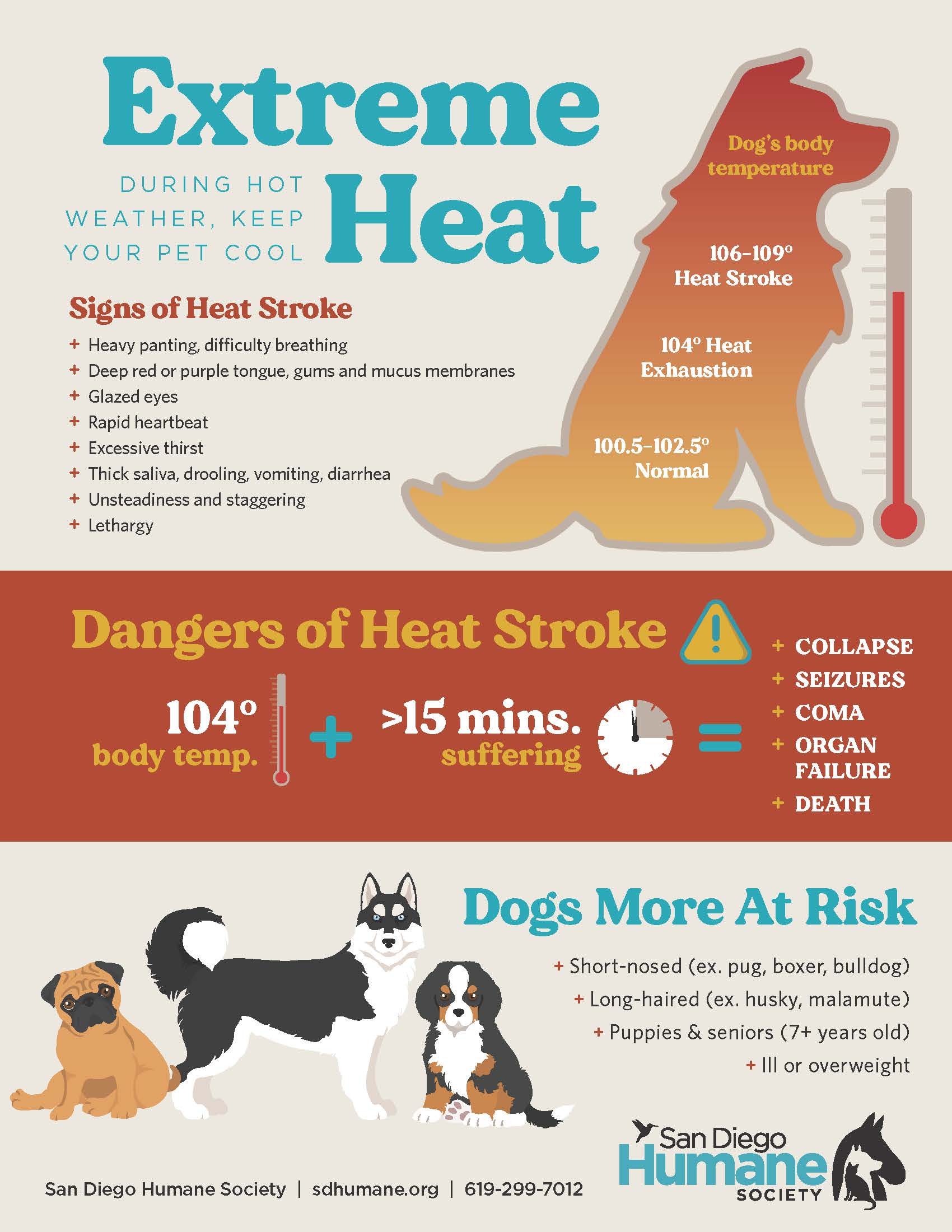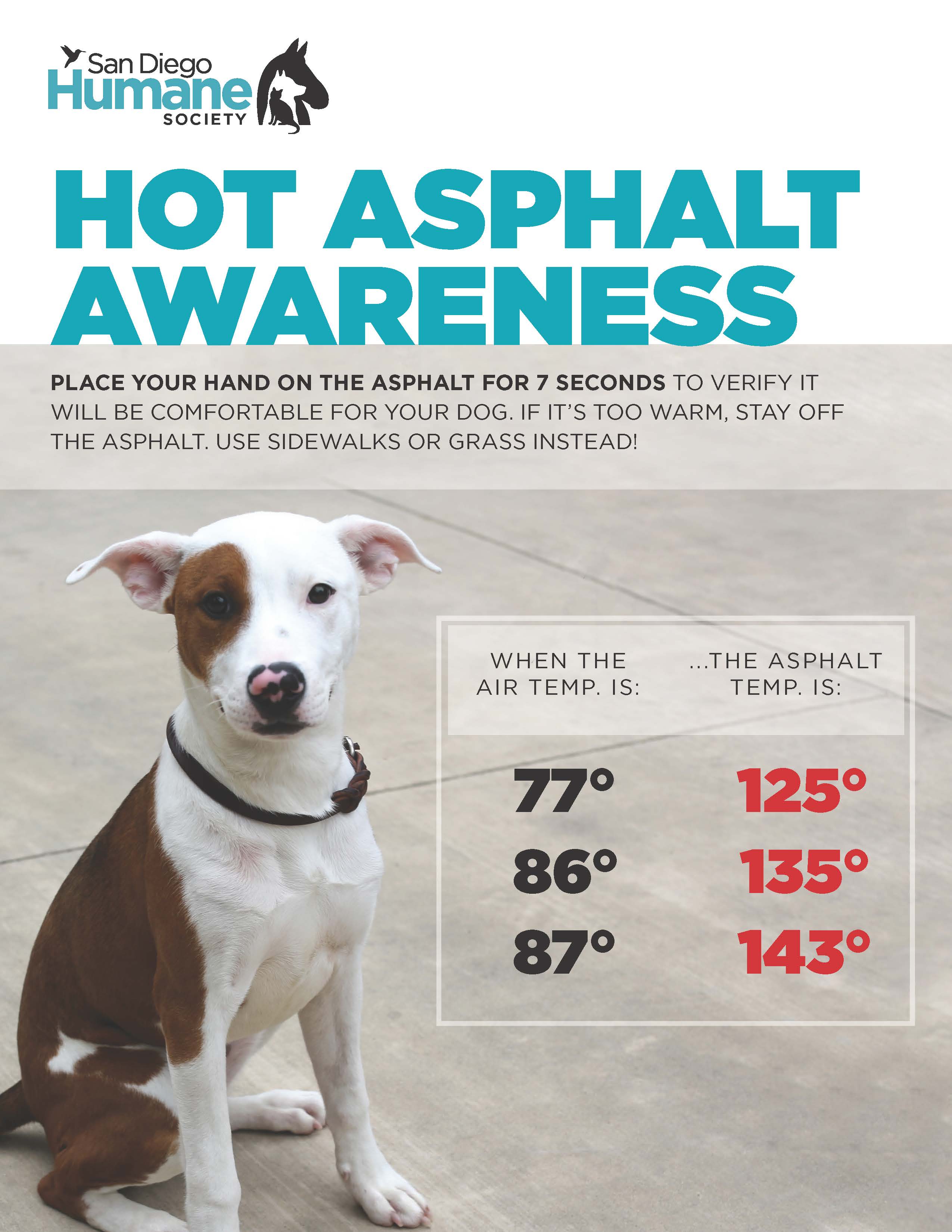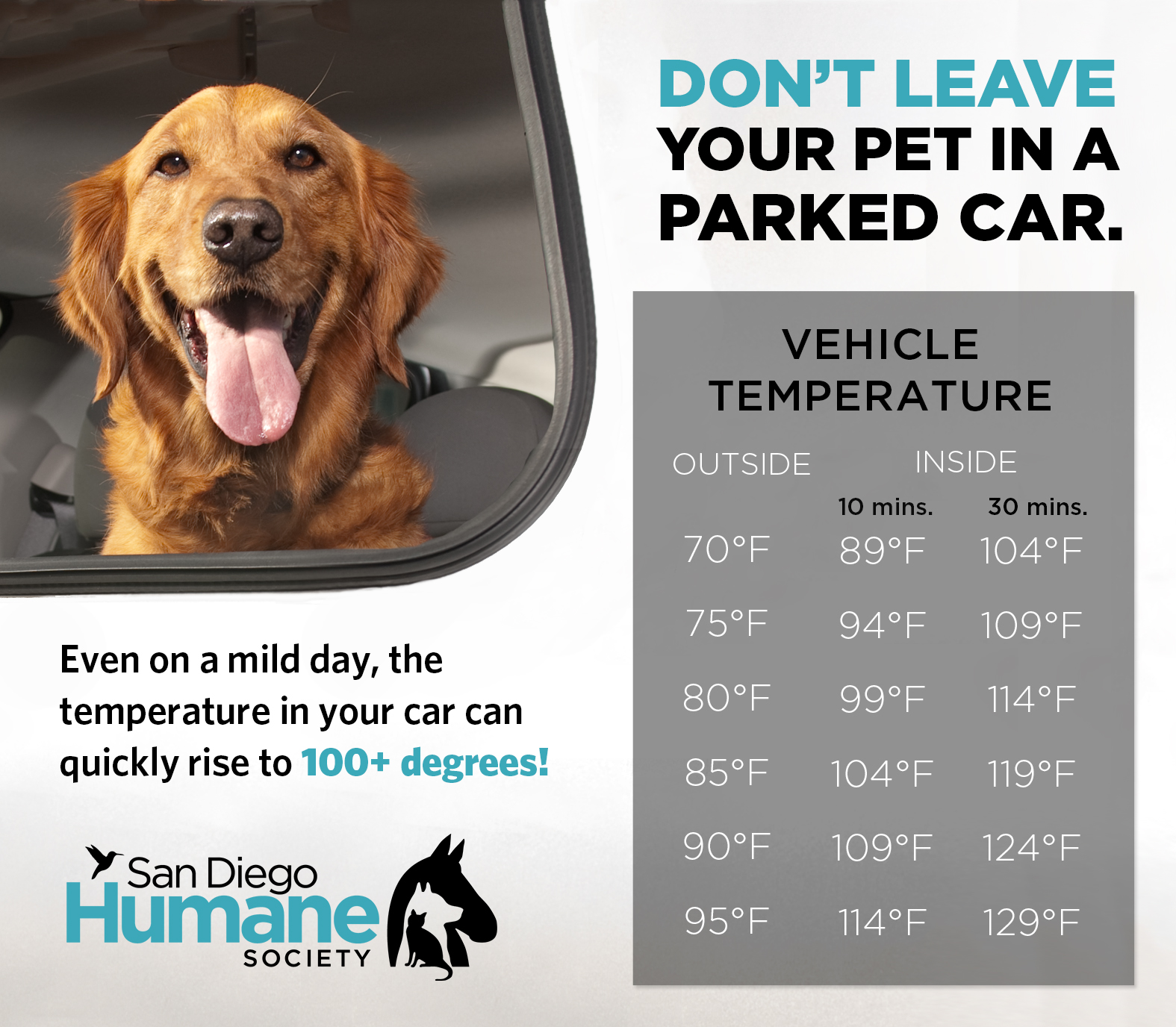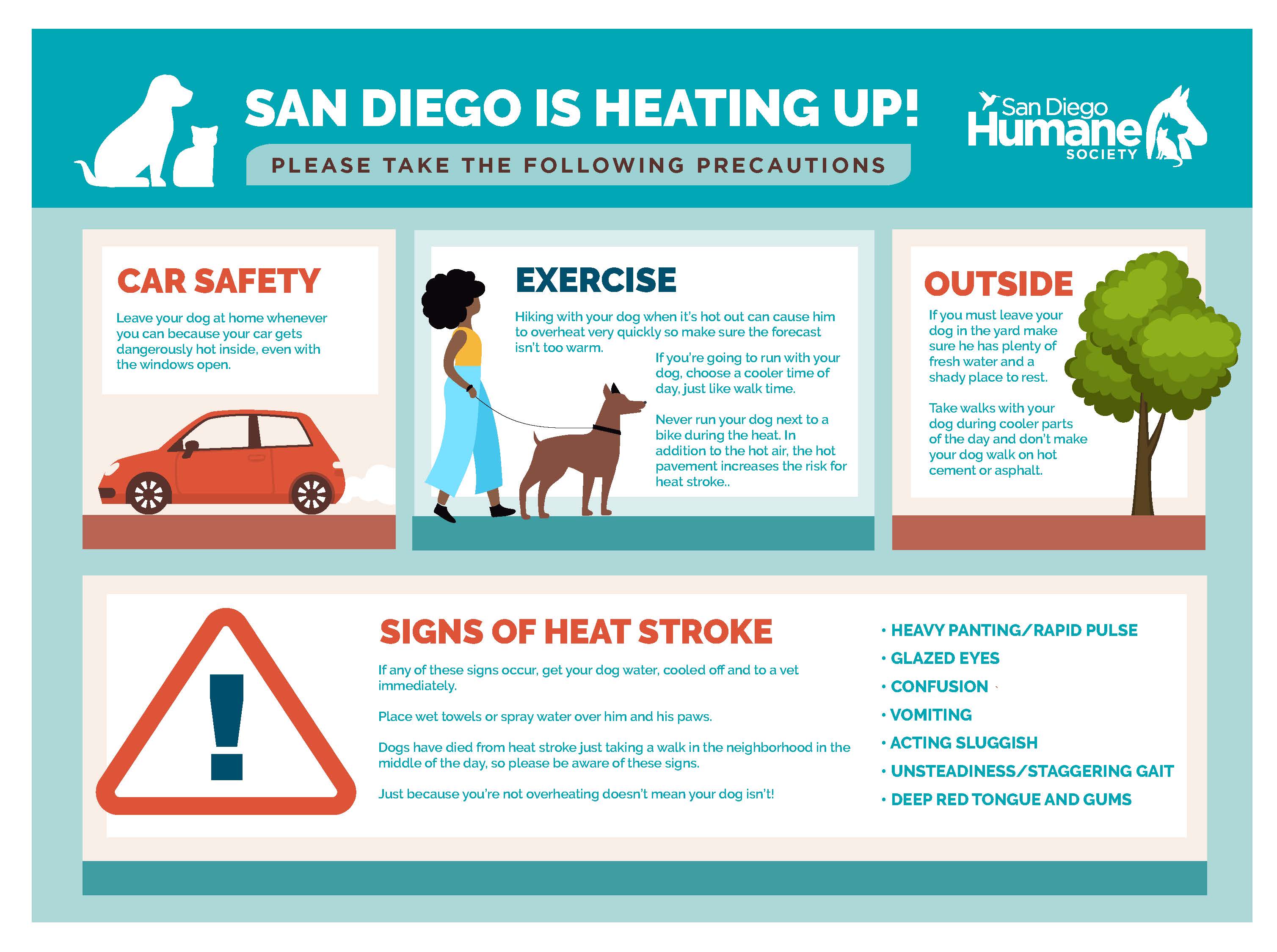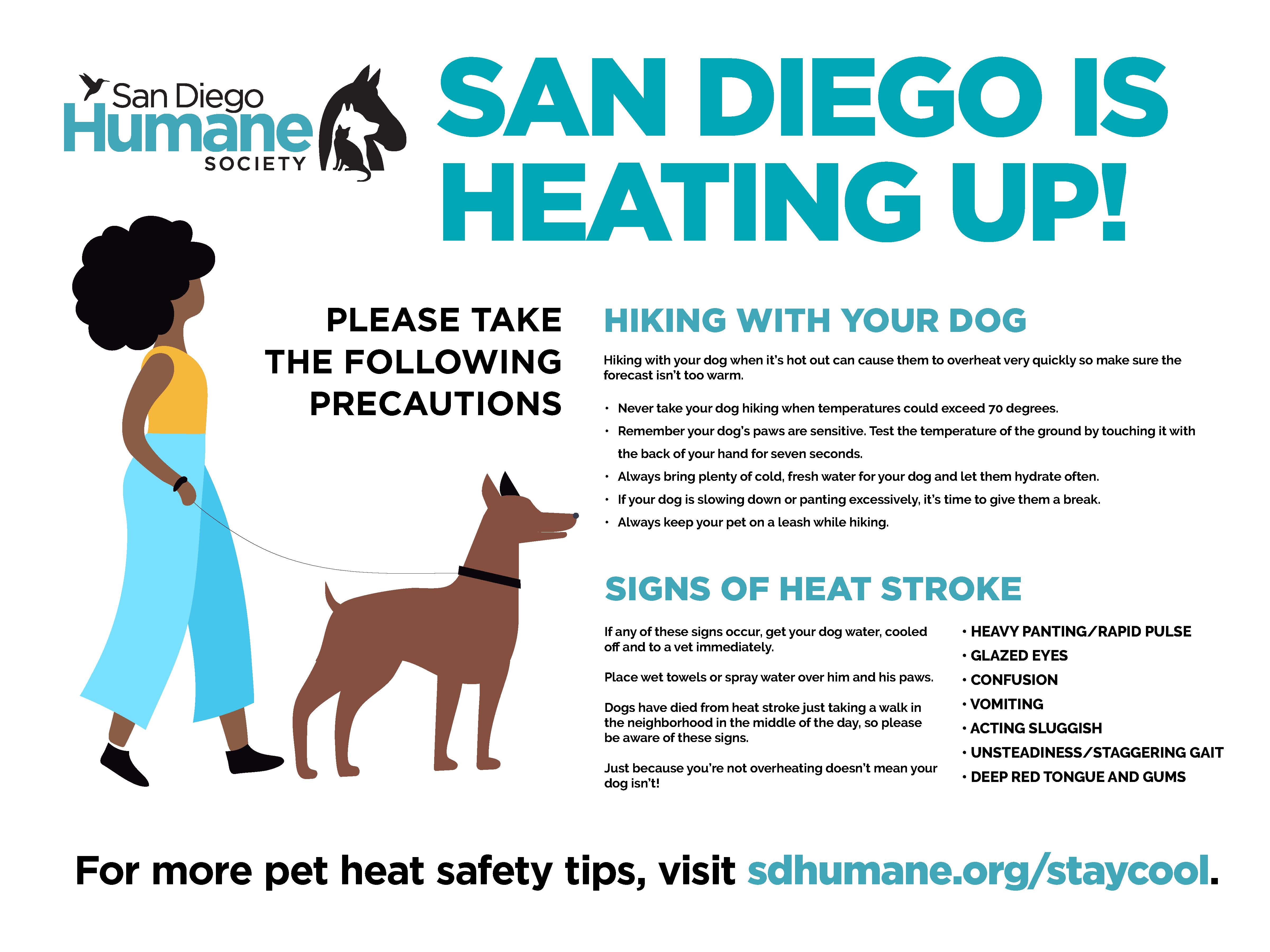Pet Heat Safety
When temperatures rise, our pets rely on us to keep them safe.
Heat can be dangerous — even deadly — for animals, but you can help your furry friends stay cool and comfortable all summer long. On this page, you’ll find easy, practical tips to protect pets from the heat, downloadable flyers and graphics you can share to spread the word, and answers to the most common questions about keeping animals safe in hot weather.
If you see an animal trapped in a hot car, call San Diego Humane Society at 619-299-7012 or your local law enforcement agency for assistance. View our Heat Safety FAQs for more information.
10 Tips to Help Your Pet Beat the Heat!
Warm weather can be tough on pets. Keep these tips in mind when it’s hot outside:
- Always provide plenty of cool, clean water for your pet. When away from home, be sure to bring along fresh water and a bowl.
- Leave your pets at home as much as possible. While you may think they’ll be lonely, they will be much more comfortable in a cool home than riding in a hot car.
- Never leave your pet in a parked vehicle. Even with the windows open, a parked car can become deadly within minutes. If the temperature outside is 80 degrees, the temperature inside your car can quickly climb to 120 degrees.
- Be mindful of hot asphalt and keep walks to a minimum. Paws can burn on hot pavement, even if your pet isn’t showing signs of discomfort. To be sure the pavement will be paw-friendly, place the back of your hand on the ground for at least seven seconds. If it's cool enough that you can comfortably keep your hand there, you and your pet are good to go!
- Avoid exercising your pet in hot, humid weather. Walk your pet in the cool early morning or evening. Avoid any strenuous activities like running or hiking.
- Remember that dogs can get sunburned too! Don’t forget to protect hairless and light-coated dogs with sunscreen.
- Always provide plenty of shade. Bring your pet inside during the heat of the day and let them rest in a cool part of your house. If you take your dog to the beach or park, make sure they have a shaded spot for resting.
- Keep your pet well groomed. A clean coat can help to prevent skin problems from the sun and heat. It’s important to know what works best for your pet — while some dogs benefit from being trimmed short in the summer, others rely on their heavy double coat to keep them cool!
- Use flea and tick prevention. Over-the-counter and prescription medicines are available — ask your veterinarian for a recommendation.
- Be alert for the signs of heat stress: heavy panting, glazed eyes, a rapid pulse, unsteadiness, a staggering gait, vomiting, or a deep red tongue. If you believe your pet is suffering from heat exhaustion, contact your veterinarian right away — it could save your pet's life.
Shareable Resources
These ready-to-use resources are packed with tips for protecting animals from the heat. Share them on social media, print and post them in your neighborhood, or pass them along to friends and family — every share could help save a life.
FAQs
Why is heat so dangerous for pets?
Unlike humans, pets only have a few sweat glands — mostly located on their paw pads! This means they have to rely on less efficient ways to cool themselves, like panting or lying on a cool surface. They also can’t tell us when they are too hot, so it’s important that we pay close attention to the signs they might be overheating.
How do I know when it’s safe to walk my dog outside?
When temperatures are expected to exceed 70 degrees, it’s best to walk your dog early in the morning or late in the day. Before going for a walk, test the temperature of the ground by placing the back of your hand on it. If you can comfortably hold it there for 7 seconds, it’s safe for a walk. If your pet begins to show down or pant excessively during the walk, it’s time to give them a break.
How can I exercise my dog when it’s too hot?
There are many alternative ways to keep our pets busy and enriched during the hot weather! If you’re not able to get out for an early morning or evening walk, try out some indoor activities. These can include puzzle toys, snuffle mats, training games, hide-and-seek and more. Explore our pet enrichment resources for ideas that will support your pet’s mental and physical health while keeping them safe from the heat.
What happens when a pet has heatstroke?
Heatstroke occurs when a pet’s body temperature rises above normal levels (100-103.8 degrees). This causes an inflammatory response throughout the pet’s body that — depending on how long their temperature remains elevated — can damage their internal organs. Risks include damaged brain cells, cardiovascular shock, respiratory distress, kidney failure and blood coagulation. Heatstroke can lead to death if untreated.
How can I tell if my pet is overheating?
Signs of heatstroke in pets include heavy panting, confusion, acting sluggish and very red gums and tongue. As the severity increases, heatstroke can lead to vomiting, diarrhea, incoordination, collapse and seizures.
What should I do if my pet seems to be overheating?
It’s important to take action quickly to help cool your pet down! Steps include moving them to a cool, well-ventilated area, placing wet towels on their body or spraying water on them (never ice, which can cause shock) and offering them water. If they are showing more severe signs of heatstroke or are unconscious, take them to a veterinarian as soon as possible.
Are some pets more at risk of heatstroke?
Yes! Puppies, kittens and senior pets are not able to regulate their body temperature as well as adult pets. Pets that are overweight or have dark coats are also more at risk. Brachycephalic pets (flat-faced, like bulldogs and pugs) cannot pant as effectively, which also puts them at higher risk. Lastly, pets with health conditions such as heart disease, kidney disease and diabetes are more heat sensitive.
What should I do if I see a dog trapped in a car in the heat?
If you see an animal in distress inside a car, act quickly but safely — there are legal steps you should follow. California's "Right to Rescue" Act, provides legal protection to individuals who rescue animals from vehicles when they are in immediate danger due to conditions like extreme heat or cold, inadequate ventilation or lack of water. The law grants civil and criminal immunity to Good Samaritans who break into vehicles to save these animals, as long as they follow specific steps. Here’s what to do:
- Assess the situation: Look for signs of distress such as heavy panting, drooling, weakness, confusion, collapse or unresponsiveness. Note the car’s make, model, color and license plate.
- Try to locate the owner: Alert nearby businesses, stores or venues. Ask them to page the owner.
- Call for help immediately: Dial 911 or your local Humane Law Enforcement. If you live in San Diego Humane Society’s jurisdiction, can call dispatch at 619-299-7012 (press 1).
- Understand your rights: California law allows a person to take reasonable steps to remove an animal from a vehicle if the animal appears to be in immediate danger — but you must first call law enforcement. You must wait for them to arrive unless it's clear the animal’s life is in immediate danger and help isn’t coming quickly.
- If you break in: Stay with the animal in a safe location until law enforcement or animal control arrives.


